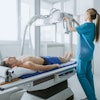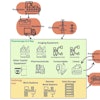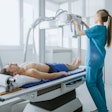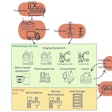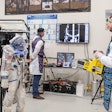
When it comes to new multimodality imaging systems that provide vascular as well as cardiac information on patients, some interventional radiologists may be leery about working side by side with cardiologists. For others, sharing services can mean more professional opportunities.
As imaging technology continues to more forward, however, different specialties must work together, said Don Volz, director of x-ray vascular business unit at Toshiba America Medical Systems in Tustin, CA. And when this occurs, patient care is better.
Two major forces driving imaging technology include hospitals' demand for quality imaging at a lower cost and the need for imaging technology to keep pace with the emergence of smaller guidewires, catheters, and other devices, noted Mark Lothert, director of product marketing, interventional radiology, at Siemens Medical Solutions in Malvern, PA.
"In the past, we could offer cardiac imaging systems that could also perform peripheral subtracted vascular imaging, and vice versa," Lothert said. "But, these were two separate system platforms with some compromises."
"Today, we offer one platform with both vascular and/or coronary imaging," Lothert continued. "These systems provide a larger field-of-view for the radiologist, as well as a smaller field-of-view for the cardiologist." So, for instance, a 12 x 16-inch flat-panel detector can be rotated from landscape to portrait to meet the needs of both radiologists and cardiologists.
Neither specialist will sacrifice efficiency or resolution in a shared system, Lothert added. For instance, Siemens' Axiom Artis series flat-panel detector technology provides the radiologist with up to 30 frames per second.
"Using an image intensifier, the cardiologist can acquire up to 60 frames per second," Lothert said. "Images acquired with an image intensifier or FD technology are very detailed, permitting doctors to better visualize -- and more accurately place -- catheters, stents, and guidewires based on excellent contrast and spatial resolution."
Multimodality systems are particularly attractive to smaller or midsize hospitals whose budget or patient load accommodates only one imaging room and one system, Lothert said. They make it possible for the radiologist and the cardiologist to work in a cooperative atmosphere, where neither specialist nor patient must compromise his or her needs, Volz added.
"Emerging applications will give interventional radiologists some great opportunities to expand their practices over the next several years," said Brad Fox, general manager of global cardiovascular x-ray at GE Healthcare in Waukesha, WI. Advancements in imaging technology will help facilitate these new applications and procedures. These, in turn, will shape healthcare practice for the interventional radiologist, Fox added.
Technological strides
One of the biggest leaps in interventional imaging technology has been the recent introduction of digital flat-panel detectors. For the radiologist, this translates to higher image quality on larger fields-of-view without the trade-offs inherent to intensifier-based systems. This is especially important for maneuvering hard-to-see devices under high frame rate, and low-dose fluoroscopy, according to Fox.
GE's flat-panel technology, for instance, offers image quality improvements over conventional systems, and provides greater dose efficiency, Fox said. For example, published clinical studies have shown dose reduction of as much as 30% to 50%.
"It is essential that the flat-panel detector can be rotated to accommodate different applications that require coverage and steep angulations," Lothert said. "The interventional radiologist should also be able to work with an automated collimator rotation for anatomical correct visualization on the displays."
Flat-panel detectors enhance image quality in several ways, according to Andy Dunn, senior marketing manager of cardiovascular x-ray at Philips Medical Systems in Bothell, WA. New panels not only offer a larger, more flexible field-of-view, but also higher contrast resolution. In addition, pixel sizes have been further reduced. The imaging chain behind the panel detector now also supports 2048 x 2048 pixels, yielding a clearer image, Dunn said.
Another area of growth for imaging technology includes enhancements in 3D imaging. With 3D imaging, radiologists are assured better, more precise tools for analysis. "Today, radiologists can view a 3D volume in as little as 45 seconds, with no sacrifice in resolution," Dunn said.
In addition, it is becoming possible to integrate traditional 2D images with angiographic data for such applications as catheter tracking, according to experts at Philips. By superimposing 3D vessel views on live 2D data sets, interventional radiologists can view catheter movements in registration with 3D images.
"The level of 3D integration a system offers is very important," Lothert said. For instance, the 3D workstation must communicate accurately with the C-arm system, thereby enabling the interventional radiologist to readjust the C-arm position based on the 3D data set.
Interventional radiologists can also anticipate better and better tableside control. It is important that the radiologist is able to control everything at tableside from the sterile area, Lothert said. This frees up time and increases staff efficiency.
As the technology continues to develop, radiologists can expect multimodality imaging systems to become more efficient information integrators, Dunn said. "These systems can integrate multimodality information. The radiologist can look at a CT scan, an ultrasound, an MRI -- essentially anything using a PACS network -- for a more complete analysis of the patient."
New applications and opportunities
There is little question that interventional radiologists can benefit from the cutting-edge technology incorporated into multimodality imaging systems, according to experts. But to do so, they must offer a wider range of services and assume a greater role as clinicians. There are presently a growing number of applications opening up to interventional radiologists.
At a recent meeting of the Society of Interventional Radiologists (SIR), interventional radiologists were encouraged to increase their focus on oncology, with an emphasis on minimally invasive tumor treatments and women's health, according to Dunn. Indeed, Philips' research division is investigating a number of such applications, including soft-tissue -- or low-contrast -- imaging, targeted chemotherapy, embolism assessment, and general imaging.
Fox agreed that advancements in imaging technology are leading to new opportunities for interventional radiologists. Doctors can now shrink uterine fibroids without surgical intervention, he said. It is a one-day procedure, and the patient can return to work in a week.
Fox also foresees interventional radiologists taking an active role in developing techniques for managing abdominal aortic aneurysms nonsurgically. And, more acute stroke programs should emerge as radiologists and cardiologists begin to collaborate.
Essentially, CT and MRI will become increasingly popular as image resolution technology continues to grow stronger, Volz noted. Interventional radiologists will be able to do more applications more precisely, and their focus will extend to include more coronary and peripheral diseases, he predicted.
Purchasing considerations
The interventional radiologist plays a big role in purchasing decisions, according to Lothert. When investigating imaging systems for a wider range of applications, radiologists should ask at least two basic questions:
- What are my/my facility's priorities today?
- What direction do we plan to take in the future?
Evaluate the facility's space and budget for accommodating one versus two separate imaging systems, as well as what applications a new system will be used for, Lothert suggested. This will determine what design of system a facility should purchase, such as floor-mounted, ceiling-mounted, multipurpose, or biplane.
"If a practice focuses more on cardiac imaging than on body interventional imaging, it will usually prefer a floor-mounted unit," Lothert said. The facility may decide to start out with an image-intensifier-based system, then upgrade to a flat-panel detector later on. However, this means at least one week of system downtime later on when the flat-panel detector is added, Lothert warned. Overall, there is a clear trend toward systems based on flat-panel detectors.
"We've seen a rapid marketplace adoption of flat-panel technology because clinicians can see a dramatic clinical advantage in the imaging," Fox added. "Flat-panel technology is more expensive and will be so for the next couple of years, but this technology is a standard that clinicians feel they need to remain state-of-the-art in modern healthcare practice."
It is becoming increasingly more common for different specialties to work together under one roof, according to experts. "We are seeing more and more group practices that include interventional physicians with a background in radiology, cardiology, and endovascular surgery," Dunn said.
Fox agreed. "Today, we see new practice configurations and collaborations where interventional radiologists and cardiologists can work together," he said.
Indeed, new multimodality imaging systems are being purchased with an understanding that both the interventional radiologist and the cardiologist will jointly manage patients, Volz added. There are high-end users who find these systems very attractive.
"The radiologist and the cardiologist can share (the same space) without feeling like the system compromises his or her patients' needs," he said.
Market players
The market is quickly expanding to include several vendors who will offer multimodality imaging systems. Within the last year, however, four vendors have set some industry standards for systems that accommodate the needs of both interventional radiologists and cardiologists. The following are some key features these systems offer:
GE Healthcare
Innova 3100
- 31-square-centimeter Revolution digital flat-panel detector reportedly offers up to 10x the dynamic range of image-intensifier-based systems.
- System includes detective quantum efficiency (DQE).
- System features artifact-free imaging edge-to-edge.
- Designed to avoid geometric distortion.
Innova 4100
- Designed to provide detailed, real-time fluoroscopic images of the patient's anatomy.
- 41-square-centimeter Revolution digital flat-panel detector reportedly offers up to 10x the dynamic range and a 37-percent larger field-of-view than image-intensifier-based systems.
Philips Medical Systems
Allura Xper FD20
- Flat-panel detector with 2048 x 2048 pixel, distortion-free imaging chain.
- Designed for enhanced image resolution with 154 micron pixels.
- Image area can be adjusted from 16 centimeters to 30 x 40 centimeters.
- System features MRC x-ray tube, engineered for noiseless operation.
- System includes MRC x-ray tube collimator with radiation-free beam shaping.
- Xper Access permits user to reposition detector from portrait to landscape.
- System includes DICOM autoarchiving, as well as DICOM query and retrieve.
Siemens Medical Solutions
Axiom Artis FD-based solutions for interventional radiology
Axiom Artis dTA
- System features digital ceiling-mounted universal angiography C-arm system with flat-panel detector technology.
Axiom Artis dFA
- System features digital floor-mounted universal angiography C-arm with flat-panel detector technology.
Axiom Artis dBA
- System features digital biplane interventional neuroradiology C-arm system with flat-panel detector technology.
Axiom Artis dMP
- System features digital multipurpose C-arm system with flat-panel detector technology.
Toshiba America Medical Systems
Infinix-i Series
- Three-dimensional fusion digital subtraction angiography, designed to illustrate intracranial vascular anomalies and anatomic correlation with surrounding bone structures.
- System features Digital Fluorography Processor 8000 (DFP-8000D) digital platform for enhanced visualization of devices used in interventional radiology and dose-management benefits.
- System is designed to be field-upgradable to accommodate different detector designs.
- System features multitasking processing and simultaneous acquisition, processing, and film image storage.
- System includes complete DICOM 3.0 service class capabilities.
- Large-capacity hard drive storage designed to hold about 50,000 images.
Infinix DP-i
- System features dual C-arm system that shares one common digital generator, table, and monitor.
- One C-arm with a 9-inch imaging chain is suited to cardiac work, while the other C-arm with a 16-inch imaging chain is suited to peripheral work.
- System designed to fit into the same size floor space as a single-plane cath lab.
By Laura Thill
AuntMinnie.com contributing writer
September 21, 2004
This article was originally published in MEEN Imaging Technology News. For more information about MEEN ITN, go to www.itnonline.net.
Related Reading
GE completes Saint Francis install, September 14, 2004
Toshiba gets first Infinix-i FPD install, September 14, 2004
Toshiba gets FDA nod for new flat-panel detector, May 26, 2004
Siemens introduces three new Axiom Artis digital x-ray systems, November 30, 2003
Copyright © 2004 Imaging Technology News
